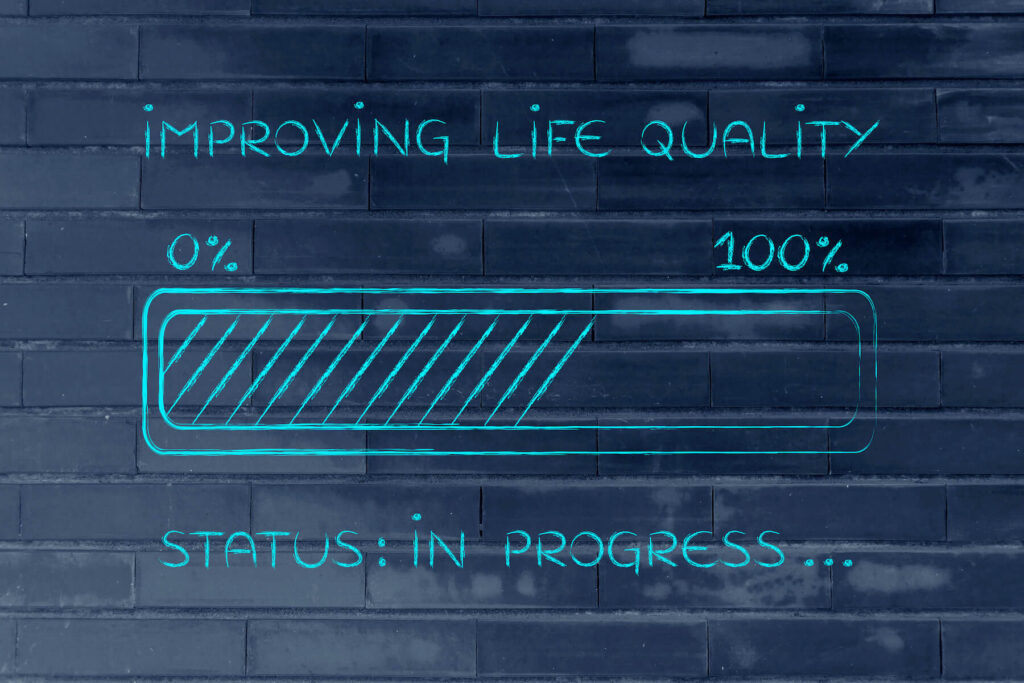Article Summary:
What is a vision of the good life? Why is it hard to create one? What are the benefits of having a vision of the good life? How to craft a vision of the good life?
+++
Working hard but lacking energy and motivation?
Busy but feeling depleted?
Not sure what you want anymore—or what direction to take?
Feeling overcommitted, juggling too many things?
These are common feelings these days, even among high achievers and committed parents and citizens. The problem is that, if we let them go for too long, things can start unraveling. We begin to see a gap between where we are now and where we’d like to be. And then the gap grows.
These are signs that we’re lacking a clear vision for our lives—or that we’ve lost sight of it. Sometimes, we find ourselves living someone else’s vision.
“Ester asked why people are sad.
‘That’s simple,’ says the old man. ‘They are the prisoners of their personal history. Everyone believes that the main aim in life is to follow a plan. They never ask if that plan is theirs or if it was created by another person. They accumulate experiences, memories, things, other people’s ideas, and it is more than they can possibly cope with. And that is why they forget their dreams.’” -Paolo Coelho, The Zahir
What Is a Vision of the Good Life?
A vision is a bold and vivid picture of a better future. Many organizations have a vision statement. But vision isn’t only for organizations. It’s for us too.
In the context of our lives, a vision of the good life should clearly describe who we want to become, what we want to do, and where we want to go. A vision of the good life is the dream destination of our lives.
“Vision is a clear mental picture of what could be, fueled by the conviction that it should be.”
-Pastor Andy Stanley, Visioneering
In essence, our vision statement is an authentic rendering of how our purpose and core values can play out in the world. A personal vision statement asks:
Who do we want to be?
What do we want to do and contribute in life?
Who do we want to share it with?
Why Vision Is Hard
Crafting a vision of the good life can be difficult for many. There are many obstacles that can get in the way.
For starters, we’re constrained by what researchers call “presentism”: Harvard University professor Daniel Gilbert notes that our “imagination cannot easily transcend the boundaries of the present…. Most of us have a tough time imagining a tomorrow that is terribly different from today.”
Many of us have what’s called “status quo bias”: a preference for maintaining our current state of affairs. There’s also the fear factor. It takes courage to confront obstacles and still envision a better future.
Another challenge is the trap of caring too much about what others think. This can direct us toward the vision of others and away from our own vision. Other traps that can get in the way include the complacency of drifting through our lives or settling for just okay.
Some people resist or struggle with the idea of having a vision of the good life because it sounds abstract and distant. But neither “vision” nor “good life” has to be complicated. A vision, as we’ve seen, is simply a picture of our desired future. And authors Richard Leider and David Shapiro define the good life simply and crisply:
“living in the place you belong, with the people you love, doing the right work—on purpose.”
Keep in mind that vision is different from purpose and goals. Our purpose is our reason for being, and we should think of it as timeless. Our goals are the objectives we want to accomplish, and they’re best thought of in shorter increments (e.g., today or this month or year). By contrast, our life vision is a vivid description of what we aspire to do with our lives. It’s best thought of over a lifetime (or at least a decade). (Obviously, people can choose to have a three-year vision, a five-year vision, etc. if they wish.)
The Benefits of Having a Vision
Having a vision of the good life can be catalytic. It can help us:
- develop a clear sense of direction
- get recentered when we feel lost
- put our precious time and energy into what we really want
- reclaim a sense of agency and control over our lives
- know where to focus our attention and energy—and which detours to avoid
- connect the dots between the different aspects of our lives
- get back in the driver’s seat of our lives
- make decisions and select which opportunities to pursue
- set and enforce personal and professional boundaries
- craft our goals, since they should flow naturally from our vision
- get our motivation back, even during difficult times
- boost our confidence
- help us overcome doubt and fear
- reduce our feelings of overwhelm because we’re clearer about what matters
- get help from others because we have a clearer sense of what we want
- live more proactively and intentionally
- improve our performance
How to Craft a Vision of the Good Life
There are many ways to approach crafting a vision of the good life. Different approaches will work for different people. Here are some suggested approaches:
Begin by looking back to our childhood dreams. Many of us had dreams when we were younger—dreams, for example, of being an astronaut or an athlete, an author or a ballerina, a teacher or a firefighter. Many times, those dreams don’t so much point to the profession we actually choose as they do contain certain clues about our deeper make-up as a person—clues like wanting to explore, be active, create, make beauty, or help others.
Get in the habit of thinking more about the future we want, including who we want to be and how we’ll go about making it happen.
Think not just about big accomplishments but also about what we’d like everyday life to be like. Think about our normal days in the future. A vision of the good life isn’t only about aspiration and accomplishment. It’s also about peace and joy.
Look inward to capture our authentic essence. Our articulation of where we want to go should be grounded in who we are. Many people don’t look inward before projecting outward.
“Your vision will become clear only when you look into your heart.
Who looks outside, dreams. Who looks inside, awakens.”
-Carl Jung, Swiss psychiatrist
Clarify not only the mental picture of our desired future but also how we seek to feel in that desired future. That can include the feeling we want to bring to that future as well as the feeling we want to get in it.
Reflect on our view of the good life. What would living a good life mean for us and those we love?
Ensure the vision covers the important areas of our lives. A well-designed vision paints a picture of our desired destination across all the important aspects of our lives: family, work, health, education, service, community, hobbies, travel, and perhaps more.
Think also about an audacious aspiration for our life—something that’s challenging but would be amazing if we could make it happen.
“Fortune favors the audacious.”
-Desiderius Erasmus Roterodamus
Dutch Christian humanist, theologian, and philosopher
Now take inputs from the points above and turn them into a vision statement draft. Start with statements or bullet points, and then form them into a paragraph or a page or two about our vision of the good life. It works best when we think ahead and put ourselves in it, writing in the present tense, noting what kind of person we are, where we are, who we’re with, what we’re doing, etc.
Think about how we’d like to be remembered by loved ones and others at the end of our life. What would be a life we’d be proud of?
Get clear on what would provide the most value to the people we’re committed to serving. How are we best positioned to help, given our strengths and passions, and which groups or causes?
Get clear on the things that provide the most meaning in our lives and build those into our vision, including what’s important to us and what would be worth spending our time on. It’s a good sign if we’d do it even without getting paid for it.
Share an early draft with trusted friends and colleagues and seek their input—and help. Revise it based on their input, but only the input we wholeheartedly agreed with. After all, this is our vision of the good life, not theirs.
Consider working with a coach or mentor to help with the vision crafting process. Often, it’s helpful with an outside perspective.
(See the Appendix for other options if these approaches aren’t working for you.)
Criteria to Use in Crafting Our Vision
For some, the vision crafting process will be one of the most valuable things they ever do. Given that, we should have a high standard for the output and a good process for developing it intentionally.
As we craft a vision for our lives, we should ensure that it’s:
- Clear and vivid in its description
- Aligned with our true authentic essence, unique to us, including our purpose and core values
- Unbounded by the status quo
- Distant enough that we have to work toward it (a lifetime, or at least ten years in the future)
- Broad enough to encompass all the major aspects of our lives (including personal, professional, and relationships)
- Motivating and inspiring to us, flooding our heart with palpable emotion and fueling us with conviction
Our life vision should fill us with energy and raise our sights for what we can do with our days on Earth.
Some Cautions about the Vision Process
There are many potential pitfalls in the vision crafting process, so some cautions are in order.
Though clear and vivid, our vision shouldn’t be prescriptive. It should be directional but not tactical, not interloping into how we will get there (the realm of strategy and tactics). Also avoid making it vague and generic. Someone who knows us well should recognize us clearly in our vision.
Our vision can change over the years, and that’s okay. But if we’ve done it well, it shouldn’t change too often. That would be jarring and confounding.
Our vision statement doesn’t have to be perfect. View it as a draft—as a work-in-process that can and should change over time.
Watch out for too much focus on ego or material possessions in our vision. We know those are false friends destined to disappoint in the final analysis. Better to focus instead on connection and contribution.
Our vision is worthless without action. What’s the point if it just sits in a drawer? We’re wise to read our vision statement regularly (e.g., every month or quarter) and get to work on making it come alive.
Making Our Vision a Reality
It’s unrealistic to expect that we’ll travel a linear path to realize our vision. Stuff happens. Circumstances change. But we’re wise to hold fast to our vision and keep working to bring it to life.
“A vision without a plan is a delusion.”
-Neil Kurtz, CEO of Golden Living
We’re especially wise to clarify what knowledge and skills we need to develop now to be able to live into that desired future—and then block out time to get them.
We should start taking action now on things that will bring us closer to our vision—and do that every day.
“First say to yourself what you would be; and then do what you have to do.”
-Epictetus, ancient Greek Stoic philosopher
Conclusion
In the end, our lives are short. Many people find themselves late in life with deep regrets. Why not set a marker now for how we’ll live and then pursue it with abandon?
Reflection Questions
- Do you have a vision of the good life?
- To what extent are you clear about what a good life would be for you?
- Is it informing the choices you make and actions you take on a regular basis?
- Are you moving toward it?
- What’s stopping you?
Tools for You
- Traps Test (Common Traps of Living) to help you identify what’s getting in the way of your happiness and quality of life
- Quality of Life Assessment to help you discover your strongest areas and the areas that need work and then act accordingly
- Personal Values Exercise to help you clarify what’s most important to you
- Passion Probe to help you find the things that consume you with palpable emotion over time
Related Articles
- “The Problem with Lacking Clarity in Your Life”
- “Are You Drifting through Life?”
- “Tired of Settling?”
- “How to Discover Your Purpose”
- “How to Discover Your Core Values”
- “How to Discover Your Passions–A Passion Probe Tool“
- “Goal-Setting Best Practices: Beyond SMART Goals“
- “Golden Handcuffs: Stuck in a Job You Don’t Like?”
- “The Trap of Losing Ourselves”
- “Pretending to Be Someone We’re Not”
- “Are You Playing the Long Game?”
- “The Trap of Living Someone Else’s Life”
- “Time to Check the Path You’re On?”
- “How Inertia Keeps Us from Making Needed Changes”
- “The Power of Relationships in Our Lives“
Appendix: Other Options for the Vision Process
The visioning process is challenging for many. What works for one person may not work well for another. With that in mind, here are some other options for the vision crafting process:
Start with a “mind map.” Take a blank sheet of paper and a pencil, then write the word “Vision” in the middle of the page. Then add words, phrases, or images all around the page with things that may be included in your envisioning of a good life. Don’t edit. Just write or draw.
Use a vision board. Gather an array of photos, images, inspirational quotes, or other symbolic representations of your idea of a good life. Place them on a large poster sheet that can be displayed prominently in your home or office as a visual reminder of what you’d like your life to be like.
Consider drawing your vision of the good life. (Some way want to start with this.) The point isn’t artistry but rather creative symbols that represent your deepest aspirations. Have fun with it. Aristotle observed that “the soul never thinks without a picture.”
Consider journaling as a place to start to gather ideas. Sometimes starting more informally with private thoughts can help break the logjam of self-consciousness.
Clarify how you define success in different areas of your life, including both personal and professional. Build the most salient aspects of your desired success into your vision of the good life.
Write a letter from the future. Imagine yourself at the end of your life, having lived a good life. Write a letter from that future version of you to the you of today, describing what life is like, who you’ve become and what you’ve done, and how it feels.
Postscript: Inspirations on Vision
- “There is no favorable wind for the sailor who doesn’t know where to go.” -Seneca, ancient Roman Stoic philosopher
- “I’ve seen the promised land.” -Martin Luther King, Jr., minister, activist, and civil-rights leader
- “Where there is no vision, the people perish.” -Proverbs 29:18
- “I learned to organize my life around my dream, rather than try to force my dream into my chaotic life.” -Sonia Choquette, spiritual teacher and author
- “See things as you would have them be instead of as they are.” -Robert Collier, author
- “Connecting with one’s dreams releases one’s passion, energy, and excitement about life…. The key is uncovering your ideal self—the person you would like to be, including what you want in your life and work.” -Daniel Goleman, Richard Boyatzis, and Annie McKee, Resonant Leadership: Learning to Lead with Emotional Intelligence
- “…people stop dreaming because they got caught up in the hustle and bustle of surviving. And once we stop dreaming, we start to lead lives of quiet desperation, and little by little the passion and energy begin to disappear from our lives.” -Matthew Kelly, The Dream Manager
- “All mean dream: but not equally. Those that dream by night in the dusty recesses of their minds wake in the day to find that it was vanity: but the dreamers of the day are dangerous men, for they may act their dreams with open eyes, to make it possible.” -T.E. Lawrence, Seven Pillars of Wisdom: A Triumph
- “It is not true that people stop pursuing dreams because they grow old. They grow old because they stop pursuing dreams.” -Gabriel Garcia Marquez, novelist
- “The happiest people in life operate out of their imaginations and dreams, not their histories.” -Ed Mylett, The Power of One More
- “Everyone is inspired by those who follow their dream.” -Maria Nemeth, Founder and Director, Academy for Coaching Excellence
- “Be strong on vision, but flexible on detail.” -Jeff Bezos, founder and executive chairman, Amazon
- “Despite the myth of the heroic visionary leader, there is little about developing and pursuing a vision that should be a solo endeavor.” -Christopher Gergen and Gregg Vanourek, LIFE Entrepreneurs
++++++++++++++++++++++++++++++
Gregg Vanourek is a writer, teacher, and TEDx speaker on personal development and leadership. He is co-author of three books, including LIFE Entrepreneurs: Ordinary People Creating Extraordinary Lives (a manifesto for integrating our life and work with purpose, passion, and contribution) and Triple Crown Leadership: Building Excellent, Ethical, and Enduring Organizations (a winner of the International Book Awards). Check out his Best Articles or get his monthly newsletter. If you found value in this article, please forward it to a friend. Every little bit helps!







